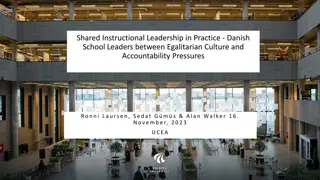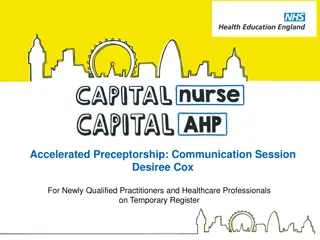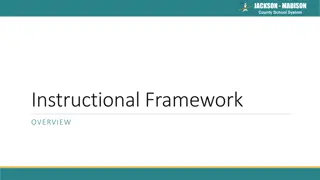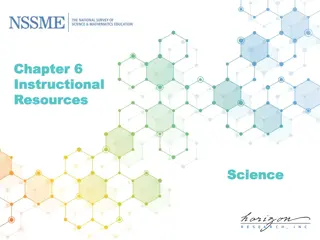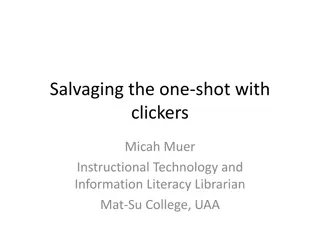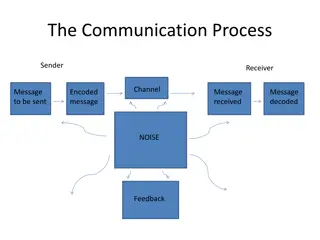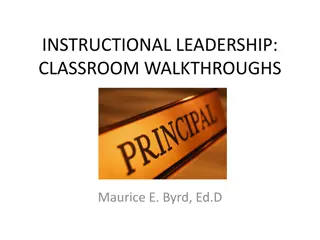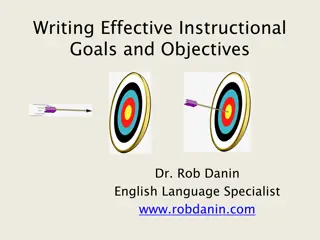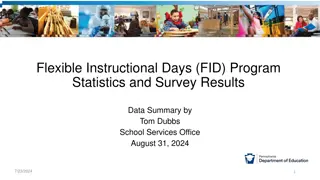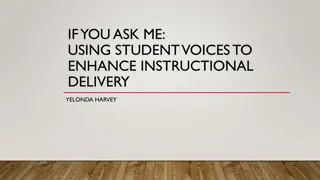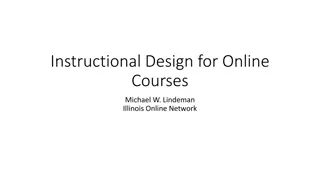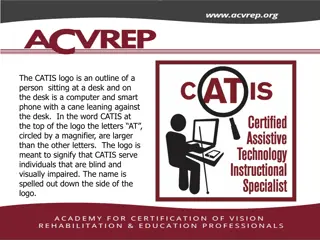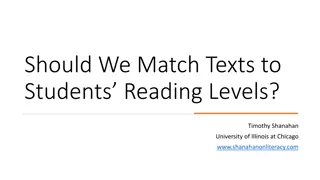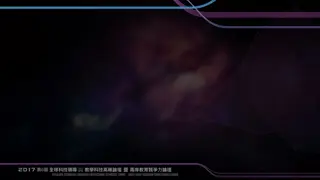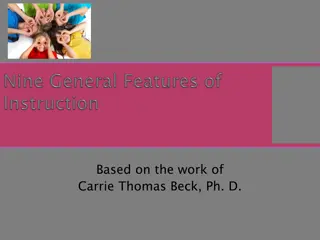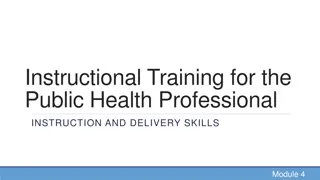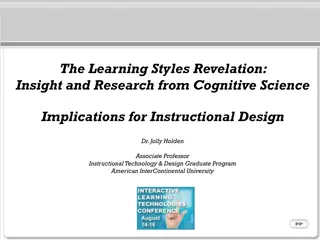Communication in Instructional Technology
Communication in instructional technology is essential for sharing information, ideas, and feelings effectively. It is the process through which social life thrives, and without it, instruction cannot succeed. Teachers must possess good communication skills to impart knowledge successfully to their students. The communication process involves various components that work together to ensure effective sharing of information.
Download Presentation

Please find below an Image/Link to download the presentation.
The content on the website is provided AS IS for your information and personal use only. It may not be sold, licensed, or shared on other websites without obtaining consent from the author. Download presentation by click this link. If you encounter any issues during the download, it is possible that the publisher has removed the file from their server.
E N D
Presentation Transcript
Instructional Technology TECS 3095
Chapter One Communication and Instruction Activity 1.What do you mean by communication? Could you define it in your own words? 2. How do you relate it with instruction? Communication can be defined as a transmissions of information from one place to another; that is the capacity of an individual to pass his/her feeling, ideas, to another; the capacity of groups, organizations, materials, etc. to convey effectively information to where it is required.
Cont.. There are many definitions of communication as there are experts in the field. Different scholars attempt to define the concept in different ways based on their own understanding, philosophy, etc. Thus, we can find different definitions for the term communication. For example, Communication, as Charles Cooley/sociologist/refers to the mechanism through which human relation exists and develops all the symbols of the mind, together with the means of conveying them through space and preserving in time.
Cont Based on the above definitions, it is possible to infer the following points about communication Communication makes social life possible because it realizes sharing of interest Social organizations including schools and classrooms cannot exist without communication because they involve information transmission. When communication organizations fails, their capacity to know, understand and own skills will also fail. among individuals and
Cont Instruction and communication are inseparable. Without communication there will be no instruction. Teachers at any educational level are responsible to have good communication skills in order to help their learners achieve what is intended. Teacher s subject knowledge can be successfully shared with their students when teachers are able to communicate effectively.
1.2. The communication process 1.2.1 Components of Communication What are the major components in the communication process? ___________________________________________ It is said that communication is the process of exchange or sharing of information, ideas, feelings, thoughts, etc. Therefore, for communication to happen, there are different components which must operate together. Hence, communication as a process involves five basic components.
They are: A. source The source of communication is the sender who has a message to impart. The sender has to decide how to communicate a message, which channel is to be selected for the message and what type of strategies should be planned so that the message makes the desired response. The source could be a person, group of people, or an institution. In the process of the instruction, the source could be a student, group of students, a teacher or group of teachers.
Factors that Influence Operation of the Source The common ones are the following. Communication skills: the ability of the source to think, write, draw or speak can impede its operation. Attitude of the source: the attitude of the sender/source towards his/her audience, the subject matter he/she is communicating or him/her. Knowledgeof the subject: his/her audience, language, media and resources used for communication, and social acceptance of the subject. The social situationin which he/she operates: The role of the source in society, the group he/she belongs to, the social background and age etc. Availability of resources: knowledge of these factors can help us to examine ourselves as sources and to evaluate communication that we receive in light of what we know about the source.
B. Message Message is the other component of communication. It refers to the content, idea, or feeling produced and sent by the source to the receiver. To make the message effective, the sender has to understand the nature and profile of the receiver of the message, his/her needs and expectations and possible response to the message.
Cont The source needs to consider mainly the following factors during communication. Code: the code has to be chosen for the message. This can be expressed in terms of a given language and the level of difficulty of the code for the audience. Content: the content of the message has to be selected and properly organized. In this case, the ideas to be presented have to be selected, tested and organized. The message is prepared and channeled by the source. Considering the receiver in mind in coding, structuring and treating the message is indispensable in the process of communication
C. Channel (Medium) Channel is the medium used to communicate a message from the sender to receiver. The channel could be spoken word, printed word, electronic media, or even non-verbal cues such as signs, gestures, body language, facial expressions, etc. The selection of an appropriate channel is crucial for the success of communication.
D. The receiver (Audience) This refers to a person or persons expected to take the message and as a result show a behavioral change. The factors that affect the operation of the source could also affect the operation of the receiver.
E.Feedback:-is a key component in the communication process because it allows the sender to evaluate the effectiveness of the message. Some of the importance of feedback in communication include:- 1. It completes the whole process of communication and makes it continuous. 2. It sustains communication process 3. It is a basis for measuring the effectiveness of communication 4. It is a good basis for planning on what next to be done especially statistical report. 5. Communication will be useless without feedback 6. Feedback paves way for generating new idea.
Noise Noise is interference with the decoding of messages sent over a channel by an encoder. Noise can occur during any stage of the communication process. The major noises are:- a.Physiological-Impairment Noise: Physical maladies prevent effective communication. For instance, actual deafness or blindness. 2. Semantic Noise: Different interpretations of the meaning of certain words affect communication. 3. Syntactical Noise: The quality of language clearly affects communication. 4. Organizational Noise: Poorly structured communication can prevent the receiver from accurate interpretation. 5. Cultural Noise: Stereotypical assumptions can cause misunderstandings. 6. Psychological Noise: Certain attitudes can also make communication difficult. For instance, great anger or sadness.
1.3 Procedures for Effective Communication Communication is a complicated process. There is no clear criterion for effective communication. Some are:- 1. Know your goals State your goals /objectives clearly. 2. Understand your audience What is my audience s background, experience? What is their attitude? What factors affect their learning? 3. Understand the ideas you are communicating Good knowledge of the subject matter. 4. Organize ideas as effectively as possible The ideas should be broken down in to meaningful logical units 5. Choose appropriate media to the audience 6. Present materials to gain the attention of audience 7. Evaluate each steps of the process
1.4. Models of communication What is a Model? In the broadest sense, a model is a systematic representation of an object or event in idealized and abstract form. Models are strategies students and teachers complicated processes by pointing out key elements of communication. There is no single model that different scholars agreed upon. As a result, we will focus on some common models of communication. for guiding through
1.4.1 The Shannon and Weavers Model Transmitter (Encoder) Channel Receiver (Decoder) Destination Informati on source Noise source The Shannon-weaver Mathematical model, 1949 This model is called the mathematical theory of communication or Information theory typically represents the one-way flow process. This model was criticized by many scholars for its linear nature. In this model the sender and the receiver have separate roles, i.e., the sender encodes the message and the receiver decodes the message.
1.4.2. Schramms Adaptation of the Shannon model Wilbur Schramm (1954) was one of the first to alter the mathematical model of Shannon and weaver. He conceived of decoding and encoding as activities maintained simultaneously by sender and receiver. He also made provisions for two-way interchange of message. The roles of encoder and decoder are interchangeable. Thus, each person in the communication process is encoder and decoder.
Diagrammatically, Schramms model looks like as follows. ____________________Field of experience_____________________ Encode Signal Sender Decode Receiver Feedback This model is called two way communication or interaction model.
Strengths Schramm provided the additional notion of a field of experience, or the psychological frame of reference; this refers to the type of orientation or attitude which interactants maintain toward each other. Included Feedback and considered communication as reciprocal, two-way. According to this model, communication is an interpretive transaction among individuals. The sender of the message encodes it according to his/her skill and experience/ and the receiver decode it according to his/her field of experience. In the feedback process the receiver does more than decode the message. knowledge/field of
1.5 Instructional Communication Communication and instruction are inseparable. Without clear and effective communication, students learning is unthinkable. Wrench, etal.(2009), state that teaching is about establishing effective and affective communication relationshipswith students. They further confirm that effective teachers are effective communicators. To make effective communication in the classroom, their subject knowledge and skill of methodology has a critical role. Teachers need to prepare their instruction carefully and implement it accordingly. As we obviously know, today classroom communication should be two way. Teachers and students interact actively.
The classroom communication model is presented as follows Students Subject matter/message/ Teacher/ sender Media/channel Noise: Learning env t, Students level of motivation Feedback Students change in behavior Comprehension of subject matter
Effective instructional communication is assumed to have the need for: 1. common understanding between the teacher and students 2.sharing of interest 3.avoiding the authoritarianism 4.participation as equals In general, effective teaching and communication are synonyms for effective teachers communicators. atmosphere of are clear
1.6 Functions of Communication What are the functions of communication? Some of the functions of communication are as follows. Information:-helps in collecting, storage and dissemination of information Socialization: communication helps individuals become active members of the society to which they belong. Motivation: it fosters community activities and motivates people to meet goals. Education: communication and education are two sides of a coin. Entertainment: people find enjoyment and entertainment the individual and
1.7 Means of Communication There are various tools and media which serve as communication among human beings. Some of the prominent means of communication are the following. Sign and sound Language Postal System Telephone Mass media Computers, internet etc. a means of
1.8 Communication Various factors can affect communication in the classroom such as Inaudibility of speech Abnormal speed of speech Unfamiliar pronunciation of the teacher Use of unfamiliar words and technical terms. without explanation Lack of understanding nature of students Daydreams and inattentiveness. Unsystematic presentation Lack of immediate feedback Lack of physical facilities Social, economic and cultural differences among the students. Barriers to Verbal Classroom
Chapter Two Basic Concepts of Instructional Media The history of utilization of instructional media to communicate information may trace back to the Stone Age. The use of instructional media started somewhere from the Stone Age period (World Encyclopedia, 2001). Today s approaches of utilizing modern instructional media and technologies are the results of this long history. This shows that instructional media are important to facilitate communication not only in the formal instructional process but also in our everyday lives.
Cont Activity 1.What is Instruction? 2.How about instructional media/materials? The term instruction is a deliberate arrangement of experiences within the learning space, classroom, laboratory, workshop etc Media according to Vikoo (2008) is used to think about Television, Satellite Communication, Computer and other sophisticated modern technologies. Instructional media are important elements of teaching and learning activities. This is why teachers globally at any level use instructional media for teaching their students.
Benefits of Using Instructional Media The benefits of instructional media include: The Delivery of Learning Materials can be Standardized The Learning Process becomes More Clear And Interesting The Learning Process becomes More Interactive Efficiency in Time and Labor Improving The Quality Of Student Learning Outcomes Foster Positive Attitudes Toward Students And Learning Materials Other benefits of using instructional media are: increases the rate of learning by the learners, makes learning to be real and permanent, saves teacher s time promote learners participation makes learning available to wider audience and; helps teacher and learner overcome physical difficulties
Classification of Instructional Media Vikoo(2003) believed that the classification should be based on some criteria. Such criteria he noted include: Degree of expertise/technical skills required for the production. Nature of the material (Media) Physiological parameter or sensory modality required Whether or not projection is involved Place produced Miscellaneous characteristic
Classifying Instructional Media Based on Convenience Durable and Non-Durable Media Durablematerials are those that last for very long time. Eg. Computer, Projectors, Television, Radio, Cameras etc. Non-Durable media that have short life span. Audio-Visual Media: Media under this classification appeal to the sense of hearing and seeing. Eg.video, television, computer motion pictures etc.
Cont Print and Non-Print Media: Print media include books, newspapers, journals etc Non-Print Media are maps, charts, postal, graphs etc. Projected and Non-Projected Media: The projected materials require other equipments especially projectors to function. The non-projected media are those that do not require any other equipment to function. Materials like poster, flash cards, charts, pictures etc fall under this category.
Chapter Three Selection and Utilization of Instructional Media The basic steps are outlined below (St. Cloud State University, 1997): Review instructional goals, objectives Determine the best medium for your lesson components Search for and review existing media/materials Adapt existing media/materials If new media/materials need to be developed, determine format, script Check for clarity and flow of ideas Conduct formative evaluation Implement/apply Evaluate/revise
Major criteria for selecting instructional media Practicality: This criterion indicates whether the intended media is practical or not. Student Appropriateness: It tells us whether the intended media appropriate for the developmental and experiential levels of the students. Instructional Appropriateness: This criteria requires checking whether the intended media is appropriate for the planned instructional strategy.
Utilization of Instructional Media Procedures in the Utilization of Instructional Materials. Media utilization follows the following procedures: Preview the materials Practice the presentation Prepare the environment Prepare the audience, and Present the materials
1. Principles in the Use of Instructional Material Principle of Selection: Instructional materials prove effective only when they suit the teaching objective and unique characteristics of learners. They should suit the age level, grade level etc They should have specific educational value besides being interesting and motivating; They should be the true representative of the real things; Principle of Preparation The teacher should receive some training in the preparation of aids; Principle of Utilization The utilization of instructional materials should be in line with the objectives of the lesson provided It should be effectively and efficiently utilized with minimum wastage.
1.Specific Characteristics of Particular Instructional Media A. Black board/Chalkboard The reasons to use the chalk board could be: Speed: We write on the board at about the same speed. Organization: You can outline the day s agenda or summarize main points Visuals: The board lends itself well to working on formulas, solving problems, Interaction: helpful in generating interaction. Tips for Using Chalkboards Always face the classroom when you use the boardeven when you write Write clearly and legibly Give your students time to take notes Plan how to use the board and structure your work
B. Printed Materials As mentioned by Seth (2009), printed materials are the literary forms of information preserved in autograph or transmitted format. They include exercise books, study guides, handouts and other print materials. They are important because they provide common visual imagery for both instructors and students.
C. Graphics/Charts These are probably much more available and used and could be easily made by teachers. Things to consider in using charts include- a) The chart should be simple, accurate and attractive. b) Consider whether the chart is needed and would do better than other resources. c) The type of data and the number of learners to benefit from the charts should be considered .
There are 4 major types of graphs. 1. Bar graphs 2. Pictorial graphs 3. Curve graphs 4. Circle (Pie) graphs
MAP A map is an accurate representation of plain surface in the form of a diagram drawn to scale, the details of boundaries of continents, countries etc.
Effective use of maps requires:understanding key or index the lines-boundary lines, lines of communication the colors, tints, shadows, symbols in a map the position of earth in the universe Types of maps Relief maps (regional and the world) Historical maps: maps in history reveal the changing times and the growth and decline of various kingdoms. Distribution maps Eg. Vegetation maps Population maps Geographicalmaps contour maps, weather maps seismological study
Power Point and Other Forms of Computer Projection PowerPoint, along with computer projections has quickly become the standard for classroom lecture presentation. There are many benefits: Visual information: with Power point, you can now greatly expand the visual content of lectures along the usual written information; Clarity: all lectures can be prepared before class with attention of detail to areas more problematic; Location: you are more free to face the class Efficiency: lectures can be revised after a class for later use. other forms of
Difficulties of Media Use These include : a) Bureaucracy and delay at the Ministry of Education b) Not many teachers see the need for media use in the classroom. c) Lack of adequate personnel to train teachers. d) Lack of enough support from heads and supervisors of education e) The impression that new technology would replace teachers f) Lack of flexible curricula g) Inadequate time and laziness on the part of teachers etc
Chapter Four Learning Modality, Memory and Instructional Media 1.Students Learning Styles and Instructional Media Everybody learns different things in different ways. How one learns depends on what is to be learned. We learn how to ride a bicycle by doing (kinesthetic learning); make bread by kneading dough with the hands (tactile learning); to sing, play a musical instrument, or appreciate music by listening (auditory learning); and, learn about the movement of the stars and planets by observing (visual learning).
A good teacher seeks as many ways as possible to present information and ideas to students and to stimulate their thinking. Similarly, practice includes providing opportunities for students to be active learners, taking into account individual differences in learning modalities/styles and providing encouragement for students to seek solutions independently. Using varieties of instructional media can be one strategy to respond to this diversity effectively. good teaching
students vary according to their learning preference and learning styles. 4.1.1 Learning through Direct Experience Commenting on the importance of learning through real objects and situations stressed the benefits of learning through their senses to make the subject of discussion more effective than in the absence of it. The implication is that pupils will remember what they see better than what they hear only and that more and better learning results from experiences gained through as many of the senses as possible.
4.1.2 Instructional Media and Memory Instructional media help to facilitate the learning of abstract concepts and ideas; to save teachers energy of talking too much; to broaden students knowledge; to increase their level of understanding to stimulate and motivate learners; and to meet individual differences. Instructional media enable learners to retain more and forget less of what is retained. They help to make learning relatively long lasting. There are research data that support these advantages of using instructional media in instructional process. One of such evidences is the fact given on how human beings make use of their senses
Edgar Dales Cone of experience clearly shows this reality. The Cone of experience shows the progression of learning experiences from concrete to abstract. Dale grouped the Cone s categories into three based on the level of experience, concreteness abstractness. These are termed as Enactive, Iconic, experiences. Each discussed as follows. or and Symbolic category is
Enactive direct experiences These are those media that are at the bottom of the cone and provide most concrete experience. This involves: I. Direct and Purposeful Experiences Direct, firsthand experiences Have direct participation outcome Use of all our senses Examples: Working in a homeless shelter Tutoring younger children in the




